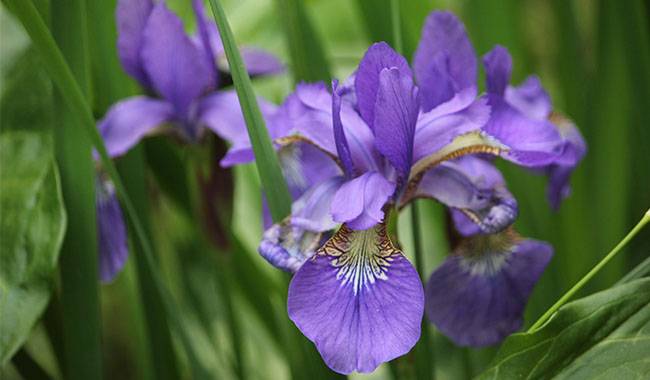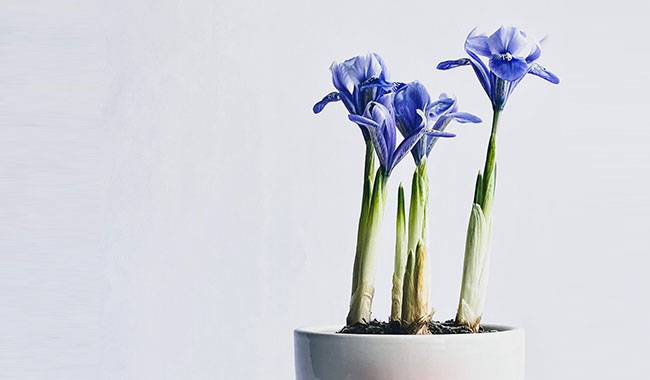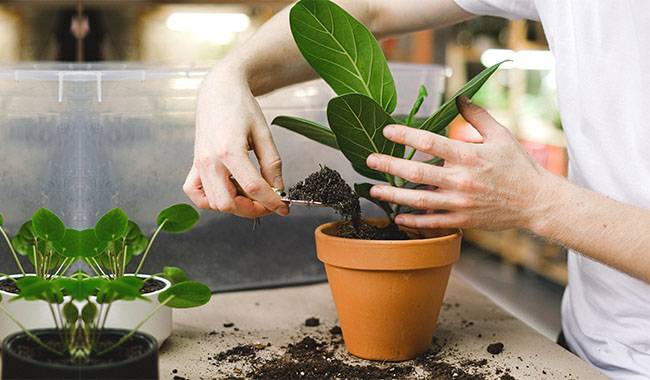
When it comes to growing Irises in pots, Iris x Germanica is considered a good choice, perfect for growing in containers. Their spectacular flowers shimmer with all the colors of the rainbow and add joy to any place in the garden, balcony, or sitting area. You will learn How to grow Irises in a flower pot at home in the thumbgarden.com article.
Irises are herbaceous perennials belonging to a large family of irises. irises are native to southern and central Europe and are now cultivated in all regions of the world. Adding Irises to your container garden is not difficult and, you will be amazed at all the colorful varieties available.
What is the Essence of Container Cultivation of Irises?
Option 1: If you want to get early-blooming Irises at home in spring (e.g. Easter). pots planted with Irises will overwinter at temperatures below 32 °F (0°C) on the insulated terrace of the greenhouse.
Option 2: You want a showy potted plant for summer garden decoration. In this case, Irises live safely in the open air, planted in a rough container and dug up from the fall. in May, you dig up the container with Irises from its hiding place and place it in a display trough. Or you can buy the rhizomes from a garden center in the spring and plant them in pots in May.
In addition to Irises, Japanese Irises are also easy to grow in containers.
Which Varieties of Irises Can Be Grown in Containers?

You will find many particularly stunning pieces at Schreiner’s Nursery in Oregon and at Cayo Nursery in France.
When potting Irises and deciding which variety to plant, determine if one blooming cycle is enough to satisfy your desires, or if more is better. Most reputable plant dealers can determine whether a particular Irises is a repeat flowering variety or one that blooms only once a year.
In addition, Irises are classified according to their terminal size at maturity. The American Irises Association classifies Irises as follows.
- Miniature dwarf Irises: These are the smallest of the Irises, standing about 10 inches (25 cm) tall and flowering earliest. The dwarf Irises (Iris pumila) variety is popular in containers. wild whispers, Royal Wonder.
- The best spring varieties of miniature Irises are Bantam (corrugated dark red-purple), Scribe (white with a blue border), and Zipper (golden yellow with a blue border). Repeated bloomers: Ditto (creamy deep burgundy).
- Standard Dwarf Irises: Plants are 10-18 inches (25-45.5 cm) tall and begin to bloom after the flowers of Miniature Dwarf Irises plants have faded. The best spring varieties are Bay Ruffles (rippled light blue), Starlight Waltz (rippled cream), Violet Lulu (soft purple), and Watercolor (yellow with brown opal). Repeated blooms: Baby Blessed (light yellow), Jewel Baby (dark purple), Plum Wine (plum red with purple), Refined (light yellow), Sun Doll (yellow).
- Medium Irises: This is another early bloomer that blooms at about the same time as the miniature and standard dwarf flowers, with plants averaging 18-32 inches (45.5-81 cm) in height.
Varieties: Baby Blue Marine (light blue), Brighten Up (orange with coral beard), Piece of Cake (pink with orchid markings), Red Zinger (deep red).
Repeat blooms: Blessed Again (light yellow), I Bless (cream), Concertina (pink), Honey Glazed (yellow), Low Ho Silver (silver and white). - Miniature Tall Irises: Named Table Irises because of their suitability for composing, these plants produce elegant and delicate flowers that range from 18-32 inches (45.5-81 cm) in height. Flowering occurs in late spring or summer.
Which Pot to Choose for Irises
Of course, when it comes to growing Irises in pots, it is always good to have an idea of the size of the pot you will be using compared to the specific Irises you will be growing. Make sure it is large enough to accommodate the plants you have chosen without the possibility of tipping over and possibly damaging the foliage or spectacular flowers.
Irises can be grown successfully in containers. Pots of 8-10 inches (20-25 cm) are suitable for compact varieties and dwarf Irises (Iris pumila); pots of 12 inches (30.5 cm) are suitable for tall Irises. even the smallest Irises have an extensive and deep root system.
When choosing the right pot, remember that Irises’ rhizomes multiply over time, so be sure to choose a large enough volume. Use containers with a capacity of at least 1.3-1.5 gals (5-6 liters), depending on the variety of Irises you are growing. In addition, Irises grow well when planted in large containers, such as urns or barrels. Just be sure to have drainage in the bottom of the container to prevent rotting problems.
When and How to Plant Irises in Pots
Your personal and regional climatic conditions determine when it is best to plant Irises in pots. Initially, they are planted in mid-May from fresh rhizomes provided by garden centers or collectors.
Irises plants in the garden are dug up and divided after flowering (late summer/early fall) and can be planted again at the same time – for example in rough containers – and then buried in the ground until the following year. This allows the root system to develop and become established until winter arrives. Or leave it in a container and take it home for early flowering.
Plant the rhizomes of Hojicha in any good mix of well-drained soil. To prevent decay, do not use thick soil that tends to collect water and remain moist for long periods of time.
To plant, place several rhizomes about 6 inches (15 cm) apart, horizontally in the soil, and spread the roots out. Spread a layer of soil so that the tops of the rhizomes stick out of the soil, uncovered. Then water the soil thoroughly and place it in a sunny place.
How to Care for Potted Irises Plants at Home

A. Watering
One of the biggest mistakes people make when growing Irises is overwatering. Unless you use an expensive terracotta porous pot, rhizomes only need to be watered lightly once a week. You can easily check the moisture content of your container soil by poking the top of the soil with your finger. If the top 2 inches (5 cm) or so is dry, you can water the plant. Only water Irises when the soil is dry to a depth of 2 inches (5 cm).
B. How to fertilize potted Irises
Many commercial potting mixes contain slow-release fertilizers that reduce the need for additional fertilization during the season. Fertilizer grades with high nitrogen content are not suitable for container cultivation of Irises because they can promote leaf growth and interfere with flower formation. Experts also note that too much nitrogen in Irises can lead to soft rot. Collectors recommend using a low-nitrogen fertilizer (such as NPK 5-10-10) and applying it in early spring when Irises begin to touch growth and again at the end of the season. Too much nitrogen in the fertilizer can lead to excessive leaf growth, which is detrimental to flowering.
C. How to prune and divide potted Irises
Irises are attractive cut flowers and you can cut their flower stems during and after flowering without harming the plant. However, allow the leaves to wilt naturally, as the rhizomes still collect nutrients from the leaves. Remove the leaves with a clean pruning tool only when they have completely darkened and turned brown.
Separate Irises every few years, at which point you can also refresh the soil. Lift the rhizomes out of the soil. Using a clean tool, cut the smaller central rhizome from the main central rhizome. If you are not replanting the flowering variety, discard the larger central one, as it will no longer flower. Only the smaller branches will flower the following season.
What to Do with Irises After Flowering
This plant is considered a deciduous plant because the leaves will eventually turn yellow and wither and the rhizome will collect all the nutrients to make new plants and bloom again. Once flowering is over, cut off the flower stems and leave the leaves. Gradually reduce watering. Remove yellowing leaves and trim off the green fan-shaped leaves.
After flowering, Irises containers can be buried in a semi-shady part of the garden. In winter, cover it with oak leaves. However, it is easier to treat such planting as an annual design story and plant the rhizomes into the ground after flowering. Remove the rhizomes from the container and store them in a school (or dig a hole) for later planting in pots or open ground in early fall.







